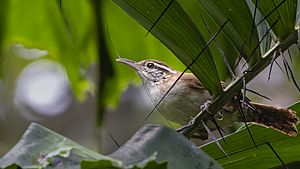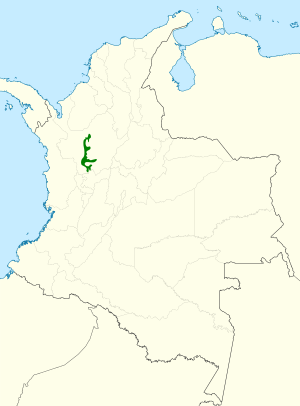Antioquia wren facts for kids
Quick facts for kids Antioquia wren |
|
|---|---|
 |
|
| Conservation status | |
| Scientific classification | |
| Genus: |
Thryophilus
|
| Species: |
sernai
|
 |
|
The Antioquia wren (Thryophilus sernai) is a small songbird from the wren family. It was first found in March 2010 near the Cauca River in Antioquia, Colombia. Scientists officially described it as a new species in 2012. Its scientific name, sernai, honors Marco Antonio Serna Díaz, a Colombian naturalist.
Contents
About the Antioquia Wren
The Antioquia wren is a type of bird known for its beautiful songs. It belongs to a group of birds called passerines. These birds are often called "perching birds" because they have special feet that help them grip branches.
What Does It Look Like?
Like other wrens, the Antioquia wren is a small bird. It likely has colors that help it blend into its forest home. Wrens are usually active birds, always moving around and looking for food.
Where Does It Live?
This special wren lives only in a specific area of Colombia. It can be found on both sides of the Cauca River Canyon. This area is known for its dry forests. Dry forests are places where there isn't a lot of rain, so the plants and animals living there are used to drier conditions.
How Rare Is It?
The Antioquia wren is considered an uncommon bird. This means that even in its natural habitat, it's not easy to find many of them. Being uncommon can make a species more vulnerable to threats.
Threats to the Antioquia Wren
The biggest danger to the Antioquia wren is the loss of its home. This is called habitat destruction. When a bird's habitat is destroyed, it loses its food sources, nesting places, and shelter.
The Ituango Dam Project
A major reason for habitat loss in this area is the building of the Ituango Dam. Dams are built to create electricity or control water. However, building a large dam can flood vast areas of land. This flooding destroys the forests where animals like the Antioquia wren live. It also changes the natural flow of the river, which can affect the entire ecosystem.
Why Protecting Habitats Matters
Protecting the dry forests along the Cauca River is very important. It helps save the Antioquia wren and many other animals and plants that live there. Conservation efforts aim to find ways for humans to develop while also protecting nature.
Discovery of the Species
The discovery of a new bird species like the Antioquia wren is an exciting event for scientists. It shows that there are still many unknown species in the world. When a new species is found, scientists study it to learn more about its life, its habitat, and how to protect it.
Naming the New Species
Scientists gave the Antioquia wren its official name, Thryophilus sernai, in 2012. The second part of the name, sernai, is a tribute to Marco Antonio Serna Díaz. He was a Colombian naturalist who studied the natural world. Naming a species after someone is a way to honor their contributions to science or conservation.
Related Wrens
The Antioquia wren is closely related to two other wren species: the rufous-and-white wren and the Niceforo's wren. Scientists figure out these relationships by studying the birds' DNA, their songs, and their physical features. Understanding how species are related helps us learn about their evolution and how they fit into the bigger picture of life on Earth.
See Also
 In Spanish: Cucarachero de Antioquia para niños
In Spanish: Cucarachero de Antioquia para niños


